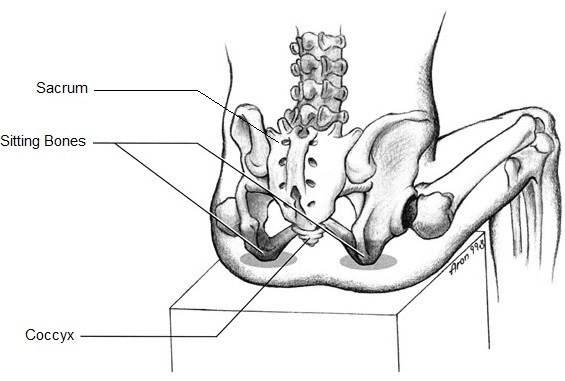You’ll need a hand towel and a firm, level, non-rolling chair. Kitchen or dining room chairs often fit the bill. If your chair is solid wood you may want to cover it with a bath towel folded once or twice, to make it more comfortable to press your sitbones into.
Many movements of this lesson resemble a Kegel exercise, but they are intended to be far gentler and slower than how Kegels are usually taught.
Many people find pelvic floor lessons particularly emotionally or culturally challenging. We invite you to pause and take breaks as needed. It’s also not uncommon to need to pause for a bathroom break.
Check the Curiosities tab for illustrations of sitbones and the breathing diaphragm, and to learn more about healthy pelvic floor function.
Sometimes people are surprised by how relatively close to their midline the sitbones are:

Here’s an illustration from Alexander Technique London to help you find your sitbones.
Regarding the “two diaphragms” mentioned early on, check out this gif animation of the breathing diaphragm. It’s vaulted when relaxed, then flattens down as it contracts when we inhale. This increases the pressure inside your abdomen, that in turn can create sense that the pelvic floor swells downward as you inhale, if we’re soft and sensitive enough to feel it.
After doing Feldenkrais pelvic floor lessons you may begin to notice in your regular life that your pelvic floor is often more contracted than you find necessary or desirable. Noticing these moments is normal and useful: it’s a necessary step toward reducing excess effort and learning better function of the pelvic floor in all your activities.
When you do notice unnecessary pelvic floor tension, don’t immediately let it go. Instead take a moment to sense it, and then experiment with gradually relaxing the tension, while noticing changes throughout yourself.
About the pelvic floor, and Kegels
In addition to being related to issues of continence, digestion and elimination, and sexual function, the pelvic floor is connected to all other actions. Ideally it is dynamically changing every moment, adapting to and assisting everything we do, just like breathing and balancing.
As discussed in the lesson, often when we think our pelvic floor is “weak” it actually just lacks variability in muscle tone. If we’re always holding it at a 9 out of 10, then there’s not much room to tighten it more when we need to!
And “strength training,” like traditional Kegels, is usually not very fruitful because brute force doesn’t get applied accurately or efficiently if we can’t sense and feel the details. When the efforts are intense, and/or we’re already chronically tight, we can’t sense and control our muscles clearly.
So one intention in these lessons is to learn to sense and use the minimum necessary tone for the moment. We’re more interested in lowering the bottom of the variability of your pelvic floor tone than raising the top.
This actually gives us a faster, stronger, and more thorough ability to increase pelvic floor tone precisely as needed, where needed, and only when needed.
This lesson is found in Patrons Monthly, our collection of lessons exclusively for Feldenkrais Project Patron-level donors.
It also appears in our Pelvic Floor: Less Is More course.
We recommend studying the lesson with the audio version above if you’re a Patron-level donor. It’s been edited and reordered for significantly better clarity. Member-level donors can access the original Zoom lesson recording as part of our Free Your Pelvis Zoom event replay.
The Zoom discussion afterwards (at the 45-minute mark) is worth a listen!
Members and Patrons. Learn more or login:
Members and Patrons. Learn more or login:





Shorter lessons for the pelvic floor really works for me. I love the slower pace and the ’less’ of it.
More of this please. Thanks so much
Glad you liked this! I agree. I felt the same sense as I reviewed our full-length pelvic floor lesson recently. Shorter options coming soon!
Great lesson! Thanks! So important to tune into the tension in our pelvic floor that we do not know we have!
Very helpful, and more sophisticated then Kegel. Need more discipline to do it ,as we age…
Thank you, Nick.
I am really happy that you teach a lesson that specifically brings focus to the sitting bones.
A couple of questions I have firstly is this lesson from a MF lesson or adapted lesson?
The other is the question about the breath, do you recommend that the pelvic floor is only lifted on the outbreath or can be either. Of course the answer is to try and see, but I am interested about your thoughts on that as you mentioned it but didn’t emphasize it.
I find my natural inclination is to inhale as I contract which creates a bigger movement but maybe a more strained movement the out breath maybe helps me reach for something more subtle.
Glad you like it! We’ve got several great lessons for getting to know your sitbones – check out the Related Lessons tab. I’m not familiar with an original Moshe Feldenkrais source for this lesson, but you can find my source in the Source tab.
I appreciate your nuanced question about how to relate the breath to the pelvic floor contractions. The short answer is where you ended: learning to let the pelvic floor expand as the diaphragm drops (meaning you are inhaling) has a subtle but important value. The biophysics, and the pattern in your nervous system, is simpler, more natural that way. But as you said, initially the subtler movement produces less feedback for you than the other way.
It is good to spend time with both, to intimately learn the difference in sensations, and to consciously switch between them. You will find, when you’re very relaxed and free, the relationship of both diaphragms dropping at the same time is spontaneous. You’ll also begin to notice more often when it’s the other way, and you’ll find an ability to instantly choose the easier way.
All of this relies on being in a pretty quiet activity. When our bodies get active, both diaphragms have huge roles supporting our movement!
Thank you.
That is very useful and addresses the questions I have about the breath in many other lessons.